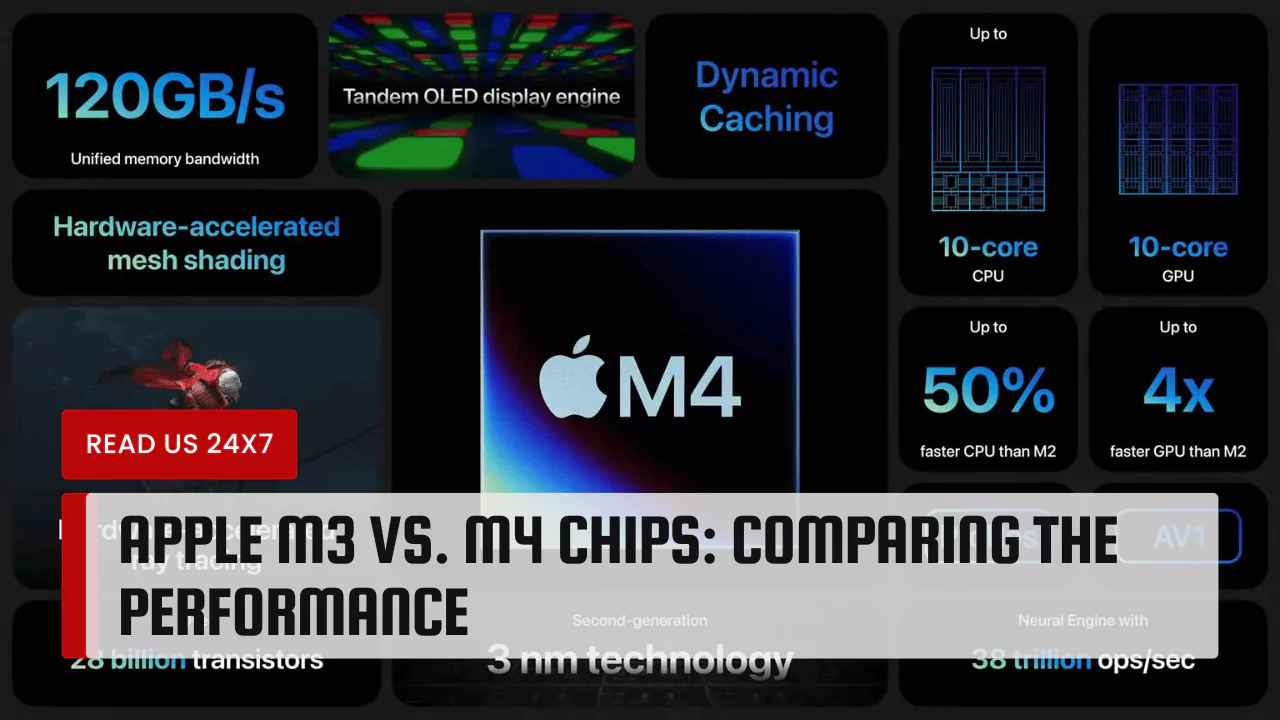The Apple M4 and M3 chips are both designed for use in Macs and iPads. The M4 chip is newer and offers improved performance and power efficiency compared to the M3 chip. It features a 10-core CPU and 8-core GPU, while the M3 chip has a 6-core CPU and 4-core GPU.
The M4 chip also supports features like ProRes video encoding and decoding, which is not available on the M3 chip. However, the M3 chip is still a capable chip and maybe a more affordable option for some users.
Overview of Apple’s M3 and M4 Chips
Both M3 and M4 are powerful ARM-based system-on-a-chip (SoC) designs. They integrate essential components like the CPU, GPU, memory controller, and Neural Engine into a single compact package. The M4, however, boasts significant improvements in CPU performance and introduces exciting new features like a dedicated display engine.
Specs and Performance Breakdown
- CPU: The M4 takes the lead with a faster CPU featuring more cores. Benchmarks illustrate this advantage, showcasing a 22% and 25% improvement in single-core and multi-core performance, respectively, compared to the M3. This translates to noticeably quicker app launches, smoother multitasking, and an overall snappier user experience.
- GPU: While the M3 and M4 have a similar number of GPU cores, the M4’s increased memory bandwidth might offer a slight edge in graphics-intensive tasks. Benchmarks are yet to reveal the true extent of this advantage, but real-world testing suggests smoother performance in demanding games and graphics editing software.
Matching the Chip to Your Needs
- M3: Ideal for everyday tasks like web browsing, managing emails, and working with office applications. It also handles photo editing and casual gaming well, making it a great choice for students, casual users, and those on a budget.
- M4: Targets professionals and power users. It excels at video editing, 3D rendering, and demanding creative workflows. The improved Neural Engine benefits machine learning tasks like facial recognition and AI-powered software. This makes it a compelling option for content creators, engineers, and anyone who relies on their device for intensive work.
Deeper Dive into M4’s CPU Enhancements
The M4’s CPU architecture is more efficient, delivering faster performance while consuming less power. Benchmarks provide a quantitative picture of this advantage. For instance, a Geekbench 6 score of 3767 for M4 compared to 3087 for M3 in single-core tests demonstrates a significant lead. This translates to quicker responsiveness in everyday tasks, from launching applications to navigating complex spreadsheets.
Beyond Benchmarks: Real-World Performance Impact
While benchmark scores are a valuable tool for comparing chips, real-world performance can vary depending on software optimization. However, the substantial lead in benchmarks suggests a noticeable difference in responsiveness and handling demanding tasks.
For everyday tasks like web browsing and document editing, the difference between M3 and M4 might be subtle. However, M4 shines in activities that push the CPU to its limits, like video editing or complex 3D modeling. Here, the M4 offers a smoother experience with faster render times and less lag.
Unveiling the M4’s New Features
The M4 boasts exciting new features that extend beyond just raw processing power.
- Running AI models with ease: The M4’s Neural Engine delivers a significant leap in machine learning capabilities. This benefits applications that leverage AI, such as image recognition software or features like removing unwanted objects in photos with greater precision.
- Enhanced Gaming Performance: While both chips offer good gaming performance, the M4’s faster CPU and potentially improved memory bandwidth could translate to smoother gameplay in demanding titles. This might be particularly noticeable in games with complex physics simulations or open worlds with intricate details.
- Smoother Video Playback: The M4’s dedicated display engine improves power efficiency for high-resolution displays like the new iPad Pro’s OLED screen. It also allows for smoother playback of high-resolution and high frame-rate videos, enhancing the overall viewing experience.
Should You Upgrade to M4?
When considering whether to upgrade to the M4 chip, several factors come into play. Firstly, if you require top-tier performance and the latest features for your tasks or applications, the M4 chip is undoubtedly worth considering.
Additionally, if you’re an avid gamer or content creator who demands the best performance from your device, the M4 chip’s enhancements can significantly elevate your experience.
However, if your current device meets your needs adequately and you’re not compelled by the additional features of the M4 chip, sticking with the M3 or your existing setup may be more economical.
Ultimately, the decision to upgrade depends on your specific requirements and budget. Evaluate your usage patterns and prioritize the features that matter most to you before making a decision.
In conclusion, the Apple M4 chip represents a significant leap forward in performance and features compared to its predecessor, the M3. With improvements in CPU and GPU performance, as well as new capabilities such as AI model processing and enhanced gaming and video playback, the M4 chip offers compelling reasons to consider upgrading. However, whether it’s the right choice for you depends on your individual needs and priorities.



